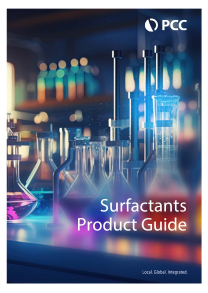Products catalog

The dynamic development of the surfactant industry is possible by the manufacturers’ focus on designing and developing innovative products used both in the production of consumer goods and in the technological processes.
Recently the word humectants has been growing in popularity. However, still not all of us know what it means and what humectants are used for. For this reason, most of us will find interesting that we, as consumers, use them on a daily basis. This is since they are an ingredient in many body care cosmetics. What are humectants? Below we present the most important facts about these raw materials, so valued in the industry.
Today we know a lot about agents such as humectants. Many of us will associate the word “humectant” with humidity. So when we define a substance as a humectant, we mean that it has moisturising properties. It is a product that excellently binds water molecules, preventing excessive drying of various surfaces.
Experts in cosmetics, pharmacy and chemistry have used the term humectants for years. However, the definition of these raw materials should be specified, as they include both substances of natural origin as well as artificial substances, which are:
Another characteristic of humectants is the fact that they take various forms. They have the form of fluids or flakes that are freely soluble in water and prevent different substances from drying out. When used as semi-finished cosmetic products, they usually go along with emollients, which are softening substances (such as butter, olive oil or other oils).
What are the examples of humectants? For hundreds of years, people have known and used various types of plant- and animal-based humectants for producing cosmetics. Examples include:
However, synthetic humectants also are widely applied in contemporary cosmetics; the names of those artificially derived semi-finished products include:
Substances that absorb and keep moisture are today broadly applied in the cosmetic industry. They are an additive which improves the properties of different formulations designed for skin, hair or nail care. What popular products contain humectants? Humectants are ingredients of:
Humectants are also being added to coloured cosmetics such as inks or foundations. They exist in colouring creams, antiperspirants, cosmetic milks and many other skin care formulations that we use every day.
The beneficial properties of humectants are used by pharmaceutical manufacturers. These water-binding substances are applied in producing, for example:
With their non-toxicity and efficacy, humectants prove to be good in drugs intended both for adults and for children.
The global demand for high-quality humectants is growing. Our knowledge about them is currently very broad, which gives a lot of possibilities and perspectives for using these substances in cosmetics. There is no doubt that humectants are amongst the safest chemicals. Most of them are of plant or animal origin. The list of human-friendly raw materials also includes synthetic humectants, such as propylene glycol or glycerine.
Humectants contained in cosmetics are safe, non-toxic, and scarcely cause allergic reactions. It should also be pointed out that natural humectants, such as Aloe vera or honey, are fully biodegradable and friendly to humans and to the environment.
The interest in natural cosmetics has grown considerably in the last decade. No surprise that plant or animal-based humectants have attracted the interest of contemporary pharmacists and cosmetologists for years. The list of the most appreciated humectants starts with honey (derived from plant pollens or honeydew), which is followed by:
The popularity of these ingredients has many reasons – what are they? Most of all, humectants perfectly bind water molecules contained in cosmetics. They also contain many micro- and macro-elements which support skin regeneration and moisturisation processes. Natural humectants act comprehensively as water binding agents, conditioners and regenerating serums.
Subscribe to receive information about new products on the Product Portal and commercial information about the PCC Capital Group
Sienkiewicza 4
56-120 Brzeg Dolny
Poland
Przemysław Kanikowski
email: iod.rokita@pcc.eu